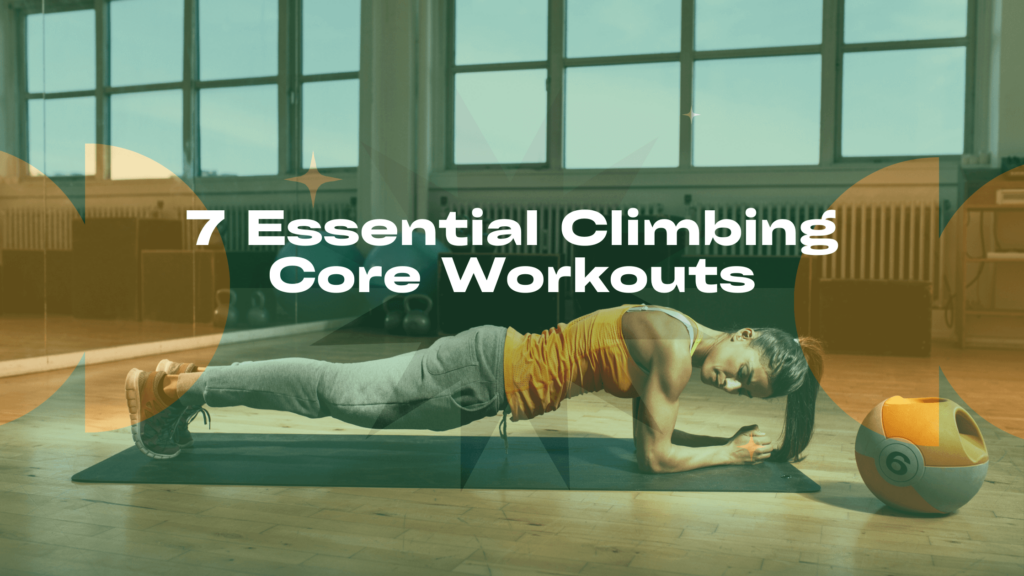Core strength and rock climbing are 100% complimentary. Climbing requires maintaining body tension in challenging poses, and a strong core enables you to keep that tension. Most people think of a core workout as one that targets the 6-pack or rectus abdominous. However, it also includes all the muscles from the top of your torso to your pelvis, anteriorly and posteriorly. Muscles such as transverse abs (beneath the rectus abdominous), obliques, serratus, lower back, and hip flexors are essential to rock climbing movements.
So, if you are looking to up your core strength, you’ll want to select workouts that target the entire core. If you’re reading this, you’re in luck, as we’ve created a guide of 7 Essential Climbing Core Workouts to level up your training. The guide contains seven exercises broken up by the core area they target. If you complete one round of all these exercises, you’ll have a quick but effective 10-minute core workout to implement into your training regime. To reap the most benefits from core workouts, you want to incorporate them 3-4 times weekly. But, if you’re new to doing isolated core workouts, gradually build up to that frequency.
7 Essential Climbing Workouts
Quality over quantity is always the priority when completing a core workout. You can increase the amount as you improve, but good form is critical to deriving the most benefits from the movements. The following exercises are divided into the core, lower abs and hip flexors, obliques, and posterior chain based on which muscles they primarily target.
Core
These three exercises will target the entire core and force full body activation. The goal is to engage not only your core all muscles from head to toe. That is quickly done by consciously flexing/activating those muscles.
1. Plank
The classic elbow plank is a tried and true solid core workout. Hold for 30 seconds to 1 minute each time you do it. The correct form involves protracting your scapula, flexing your abs, tucking your pelvis, and flexing your glutes and quads.
To make a plank easier, perform a high plank with straight arms. To make it more challenging, increase the lever by moving your elbows in front of your shoulders or curling your toes under so you’re using the top of your foot for stability (better known as plantar flexion).
2. Low Plank Cross Body Mountain Climbers
This exercise is a step up from the low plank, incorporating a rotational component, thus targeting your obliques. Hone in on the rotation, working to get your knee to touch your opposite elbow without hiking your hips up. Ideally, you can maintain an anterior pelvic tilt (hips stay level with the floor). In holding a plank position, you’ll also be working all the muscles you usually do in a plank.
3. Hollow Body Hold
Often performed by gymnasts, the hollow body hold is fantastic for core and compression strength. Keep your lower back touching the floor to ensure the deep abdominal muscles fire up and protect your lower back from injury. Keep your shoulders elevated to work the upper abs, and keep your legs straight to the lower abs into the help flexors and quads.
Lower Abs and Hip Flexors
4. Hanging Toes-to-Bar
Climbers spend significant time hanging on the wall, so why not incorporate hanging from a bar into core workouts? Hanging leg raises will tax your lower abs/hip flexors. In training for 6-pack abs, the lower abdominals are easily overlooked, but they play an essential role in stabilization and overall strength in climbing. Also, hanging from the bar will work your grip and lats, both critical for a climber. Keep your legs straight and together the entire time you’re performing the exercise. And, if you want to do a front lever (high-level calisthenics skill), you will need to master toes-to-bar first.
If reaching your toes to the bar is too difficult at first, try the following progressions:
● Hanging knee raises
● Hanging L-sits
● Hanging knee raise to straight leg lower (do a hanging knee raise, but straighten your legs in front of you before lowering them)
● Hanging leg raises (raise your legs to 90 degrees vs. all the way to touch the bar).
5. Lying Leg Lifts (with slow lower)
Doing lying leg lifts is a practical lower ab and hip flexor workout in addition to doing them on the bar. It’s also great if a bar isn’t accessible to you. Focus on keeping your lower back in constant contact with the ground and lowering your legs as slowly as possible to prevent injury and increase the intensity.
When your lower back peels away from the ground, make sure to stop and rest before continuing, as arching your back can lead to straining your lower abs and hip flexors as your body tries to compensate for the instability.
Obliques
6. Side Plank Rotations
In rock climbing, many movements require you to perform controlled rotations on the wall. Whether reaching across the center line of your body or keeping yourself from barndooring off the wall, having strong obliques will do wonders for your climbing ability.
Side plank rotations are fantastic because they combine a side plank, which targets obliques and requires full body tension. The rotational component explicitly targets the obliques, increasing the intensity. If you need to, perform these with a straight arm for an easier variation.
Posterior Chain (back, glutes, hamstrings)
7. Superman Lifts and Holds
Finally, it is vital to give some love to the core muscles that are the antagonists of the abdominals. It is easy to focus on one specific muscle group and ignore the other, but this creates muscular imbalances that lead to injury. Just like push workouts are the antagonist of pull workouts, training your mid-low back and hamstrings are critical as they are the antagonist muscles to your anterior (front body) core muscles.
Superman lifts, or holds, are a simple but effective way to target the posterior (back body) chain. Bring your lifted legs as close together as possible to make them more challenging, or keep your arms lifted and extended. More accessible variations include spreading your legs wider and keeping your arms at your sides or bent while your upper torso peels away from the ground.
If you take anything away from this article, let it be that you cannot overlook core training as a climber. And remember that when picking exercises, select a variety to strengthen your entire core (not just the flashy 6-pack). Combining the exercises from each group above is an easy way to accomplish that; you don’t need more than 10 minutes. Performing each exercise for 30-45 seconds is sufficient if you do the routine multiple times weekly. Remember that with any muscle, though, rest is important so that the muscle fibers can be repaired and the benefits of the workout set in. Comment below with any questions or additional thoughts, and happy training!

